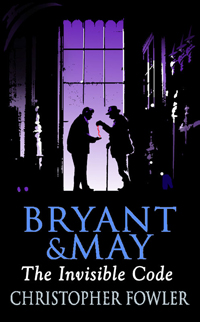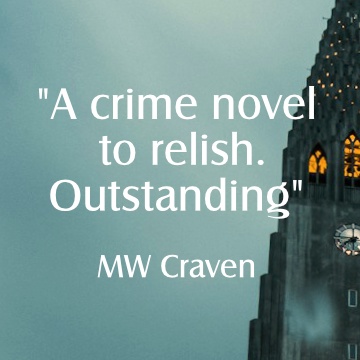 Written by Christopher Fowler — The exotic young Albanian wife of Oskar Kasavian, the Home Office mandarin and sworn enemy of the Peculiar Crimes Unit, is in trouble. She sees demons in the mirror, has attacked the snobbish wives of her husband’s colleagues, and is in danger of being sectioned. Gritting his teeth, Kasavian knows that he has only one source of redemption. He turns to the cussed, shambolic, but brilliant detectives from that selfsame Peculiar Crimes Unit – Arthur Bryant and John May. The Invisible Code is their 10th outing and it’s out now as a paperback.
Written by Christopher Fowler — The exotic young Albanian wife of Oskar Kasavian, the Home Office mandarin and sworn enemy of the Peculiar Crimes Unit, is in trouble. She sees demons in the mirror, has attacked the snobbish wives of her husband’s colleagues, and is in danger of being sectioned. Gritting his teeth, Kasavian knows that he has only one source of redemption. He turns to the cussed, shambolic, but brilliant detectives from that selfsame Peculiar Crimes Unit – Arthur Bryant and John May. The Invisible Code is their 10th outing and it’s out now as a paperback.
The unit is a constant embarrassment to The Home Office, and is viewed with the deepest suspicion by both the Met and the City of London Police. It has resisted being closed down, survived bombs and has been moved from one insanitary set of offices to the next, but when intractable and apparently unsolvable murder cases defeat the regular force, it is seen as the last – but usually successful – resort.
The two ancient investigators are already trying to discover why a young woman has died, alone, inside St Bride’s, Fleet Street, clutching a copy of Rosemary’s Baby. Her autopsy reveals little, and the only clue to her death is that she was seen scolding two small children just before her demise. When Kasavian pleads with Bryant and May to help save his wife, they agree only on the understanding that they will be allowed to keep the case of Amy O’Connor’s unexplained death inside The Journalists’ Church.
Sabira Kasavian is impossibly beautiful, painfully honest, loyal, innocent but wilful, and when a society paparazzo photographer, who has made a career out of stalking her, is found stabbed in a London park, the PCU is stretched to the limit. Are they up against a political conspiracy, or are there even darker forces at work? Another cruel death follows, and the two detectives lead a chase not just across modern London but across the centuries, as they link codes and clues buried in myth and legend.
Fowler’s plotting and style are unique. The acerbic commentary on British society overlays a foot-soldier’s knowledge of London’s streets, and makes for an irresistible cocktail. Bryant, and his slightly younger partner, May, are brilliant foils for each other, and the minor players in the PCU team are also vividly drawn. Janice Longbright, Dan Banbury, Jack Renfield and the rest of the team counter the wildly intuitive and wayward thought processes of Arthur Bryant, and bring genuine forensic skills and real policework to the party. This is actually a clever literary device by Fowler, as he makes sure there is a solid bass line of investigative procedure over which he can play the more fanciful and inventive riffs of the two main characters.
Fowler is so steeped in the topography of the capital, the hidden alleys and forgotten courtyards, its tales and ghosts, that we turn each page feeling as if some elaborate and exclusive confidence has been whispered in our ear. Even the names of his aged heroes summon memories of a distant era. There are cultural references and throw-away lines which echo Betjeman in their observation of the minutiae of English life. Quite what international readers make of this enchanting world, heaven only knows. The two detectives should, by now, be no more than plaques or commemorative rose bushes in some suburban Garden of Remembrance. But this is fiction. They bestride the world like investigative colossi. They have been hacking their way through the criminal undergrowth of London since the days of the Blitz, and if Fowler seems to have declared them immortal, then we should simply sit back and enjoy them.
Doubleday
Print/Kindle/iBook
£4.99
CFL Rating: 5 Stars









Dear David,
I’d like to say that this is by far the nicest and most perspicacious review I’ve received of the book. It once again proves that the best crime reviewers are bloggers, and I’m pleased you ‘get’ the Bryant & May novels so well. I always worry that some people don’t – otherwise I’d be on the bestseller lists, wouldn’t I?
Thanks again.